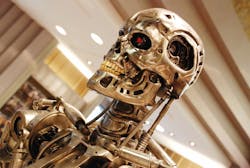The future isn’t what it used to be.
When I was growing up in the 1980s, the future looked pretty bleak when you went to the movies. There were the apocalyptic wastelands of The Road Warrior and Escape From New York. There were the dystopian nightmares of The Terminator, Robocop and Blade Runner. (Hey, want to feel old? Blade Runner was set in 2019. Escape From New York was set in 1997!)
Those visions of the future were informed by the times in which they were made, when the threat of nuclear war seemed very real, when the nightly news often showed a society consuming itself in unthinking violence. So those movies make sense. The present, after all, is the only vantage point we ever get.
But the lesson I take away from those films is how we never quite see the future coming. Back in the 1950s the future was supposed to be rocket packs and rayguns, then in my day it became cyborgs and mutants. And now the future is here, and it is… an odd rectangle of silicone and plastic I keep in my pocket that gives me instant access to the sum total of all human knowledge and experience, not to mention instant communication with anyone, anywhere in the world.
Which is good—I’m not saying it’s not good—but it’s not what I was expecting. And I’m not quite sure how to deal with it. And I think a lot of people can relate.
Some exceptional person or team of people create a new technology to address a specific problem, only to find their solution has wider, unexpected applications, and those applications end up changing the world. Alan Turing goes to Bletchley Park during World War Two so he can break German naval codes and now, nearly 80 years later, I have to deal with Tik Tok videos.
This is our big technology issue. On the cover we have a case study about how one mechanical contractor is using a software platform to get the most out of their workforce while building trust with their customers. Our Forum is about a major manufacturer using video to reach out to its stakeholders. Our Feature is about the benefits of Building Information Modeling. And in the back of the book we have our Software Showcase with a round-up of the latest software and apps.
As I’ve been putting this issue together I’ve been staggered by how much and how fast things have changed. Plumbing and heating systems used to be controlled by gravity and pressure (and sometimes huge amounts of mercury–see Pat Linhardt’s column!). Then boilers and water heaters started coming with microchips. Now they all have Wi-Fi to connect them to the Internet. What next? What’s the Next Big Thing? Because right now, someone somewhere is working on that Next Big Thing—and sooner or later that thing will make its way to you.
When I interviewed Dustin Bowerman, Sr. Director of Field Services at Bradford White for this month’s Forum, he made a very simple statement that I think everyone in the industry can agree with: product complexity is growing.
That means more training for everyone in the industry; not just to make sure you’re installing and maintaining all this new technology correctly, but so you can have intelligent conversations with your customers about what that new technology can do. We know there are amazing things just over the horizon—but no one can tell exactly what they’ll look like until they get here. The best we can do is try and keep ourselves ready.
About the Author
Steve Spaulding
Editor-in-Chief - CONTRACTOR
Steve Spaulding is Editor-in-Chief for CONTRACTOR Magazine. He has been with the magazine since 1996, and has contributed to Radiant Living, NATE Magazine, and other Endeavor Media properties.
